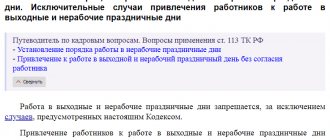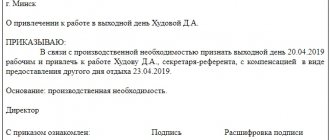Employees are entitled to time off for overtime or for other reasons. Obtaining them always requires going through a certain procedure and drawing up an application from the interested party. If a lot of unused days have accumulated, the employee has a question about whether there is a statute of limitations for time off and what it is. What should I do to prevent them from being cancelled?
What does the Labor Code of the Russian Federation say?
The Labor Code of the Russian Federation states that every employee has the right to split his vacation into several parts. But he must know that one part cannot be less than 14 calendar days. The second part of the vacation can be divided as much as you like. Each employee has the right to use these days, which are part of the second half of the vacation, at his own discretion throughout the entire calendar year.
Such days are usually called “time off”, although such a concept does not exist in the Labor Code of the Russian Federation. There is a concept of “extra day of rest”.
Extraordinary leave for family reasons
If an employee wishes to exercise his right and take time off, he must provide his management with a corresponding application. The paper is written in the format of standard business correspondence. The rules of document flow provide for a certain form of document writing. The employee can write it either in printed form or by hand, but, as a rule, it is generally accepted to write the application in hand. If the rules of internal document flow are to draw up papers on official forms, you need to write on them.
Who is entitled to time off and when?
Time off may be granted on the following grounds:
- the employee worked overtime;
- there is a need for him to perform his work duties on weekends or holidays;
- total processing during the rotation method;
- active participation in the donor movement;
- free blood donation;
- towards future annual leave;
- at your own expense.
Time off is granted on request.
There are several options for using your earned rest day:
- receive additional payment to your regular salary;
- book one more (or several) days for your annual leave;
- arrange an additional day off on any day. Which will be convenient for the employee.
Statement
In official documentation, the concept of “time off” is replaced by the term “vacation”, or “day off”.
The basis for providing it to the employee is a statement written in his own hand, which is drawn up according to a standard template.
An application for time off for vacation has a simple structure and is not difficult to draw up.
As in any official document of this type, the position and full name are indicated in the upper right corner. the head of the company or organization, and below - the position and full name. compiler. That is, it is indicated to whom the application is addressed and from whom it is made.
Below these details, in the middle of the sheet, write the word “Application”.
And finally, the text of the application itself - it must be clear, concise, and contain the main conditions of the request.
It is imperative to indicate information about the period for which the applicant wishes to receive temporary leave from work (they write in the application - leave for such and such a period, or an additional day off on account of the next annual paid leave).
The statement also indicates the reason for the request:
- marriage;
- birth of a child;
- death of one of the relatives;
- other.
If the leave guaranteed by the terms of employment has already been used, but there is a need for dismissal from work, the application says “I ask for a day off without pay.”
A date and signature are placed at the bottom of the application for time off due to vacation.
There is no uniform standard for the formatting of this document, but it is worth following the general recommendations of business ethics. It is desirable that the application be drawn up without any marks and have a presentable appearance, because it is an official document.
A standard application form can be provided by the Human Resources Department. In another case, it can be written by hand, or typed on a computer and then printed on A4 sheet. In this case, the signature must be placed manually.
How to apply
Time off is granted only on request. The application is submitted for approval to the head of the structural unit. He signs his visa, thereby agreeing. Then the application is transferred to management, and only then to the human resources department.
The personnel service issues an order assigning this employee an additional day of rest.
It is worth paying attention to some nuances when providing paid time off:
- Those days of additional rest that are provided based on actual time worked are paid in full. This rule also applies to donors;
- time off must be agreed upon with management. If this is not done, then absence from work may be regarded as absenteeism;
- an additional day is taken for previously worked time;
- For previously worked time, only one type of compensation is provided - either payment or a day of rest.
If the time off is not paid, then the following nuances are taken into account:
- You can take such time off only at your own expense;
- this must be indicated in the application;
- this day will not be paid and will not be taken into account when calculating average earnings.
That is, the lack of overtime does not allow the employee to receive an additional day of vacation. Therefore, he is left with two options:
- take an unpaid day off at your own expense;
- take a day off as part of your regular annual vacation.
The law states that it is not the employer’s responsibility to allocate leave to its employees in parts. This is his right, but not his obligation. Vacation can be split only with the approval of your superiors.
The fact is that all vacations are provided according to a pre-approved schedule. The schedule is drawn up at the end of the current year with the calculation of vacations for the next year. Not only the order of priority is taken into account, but also the interchangeability of workers. Therefore, making any changes to the schedule will certainly affect other workers.
Therefore, you need to obtain permission from your superiors to use vacation in parts. This is precisely the problem when asking for time off on account of a future vacation.
If the employer does not welcome the splitting of vacations, then he is also not willing to provide time off for vacation. In addition, the Labor Code of the Russian Federation specifies cases when management is obliged to give its employee several unpaid days:
- to all employees in the event of a wedding, birth of a child or death of a close relative. The employee has the right to demand at least 5 additional unpaid days off. But the employee must provide supporting documents;
- Working pensioners can count on 14 additional unpaid days per year if they are granted an old-age pension;
- family members of military personnel who were injured in service or died in the performance of their duties can count on 14 additional unpaid days per year;
- Working disabled people can count on 60 additional unpaid days per year;
- parents who have children under three years of age. Time off is provided by agreement with management.
Is it allowed for a business trip on a non-working day?
Sending an employee on a business trip may be accompanied by work on his days off. To receive compensation in this case, you need to pay attention to some rules.
Time off for a business trip is granted if the employee actually worked on his legal day off during his absence from the organization.
He can receive time off provided he has documents confirming this fact and a corresponding application.
Application for a day off on account of vacation
To do this, the employee must write a free-form application addressed to the head of his employer. The application can be handwritten or typed on a computer. It is signed personally by the employee.
The application shall indicate the following information:
- about the employer: name of the employer;
- Full name of the head;
- job title;
- FULL NAME;
Registration of time off
Basic requirements for the application.
Any expression of the will of a citizen must be officially confirmed by a document provided for by law. In this case, that is, with official registration of time off, written confirmation of the employee’s desire to take an additional day off will be required.
To receive compensation for overtime, an employee must first fill out a corresponding application. It can only be submitted by personally contacting the employee applying for time off to the manager.
An application for time off is drawn up according to a special template developed by the employer’s organization. The application form for an additional day off must indicate all the basic details, such as:
- addressee (employer information);
- applicant’s data (last name, first name, patronymic, position held by the employee);
- text content requesting an additional day off;
- indication of the date of the planned additional day off;
- the basis for receiving time off (it is advisable to make a link to the time sheet for the corresponding working month);
- date of document preparation;
- applicant's signature.
When entering data into the application form, you must be very careful to avoid typos and errors in the text of the document.
How long can leave be granted?
The period of unpaid leave can be any, but within the limits of the number of days of the employee’s next vacation. As a general rule, the duration of annual leave is 28 calendar days. But there are categories of workers who have the right to extended leave.
Such employees include:
- those employees whose working conditions were found to be harmful or dangerous. After the certification, the employer receives a certificate stating that some workplaces belong to the 2nd, 3rd and 4th hazard groups. Employees who work in such conditions are entitled to at least 7 additional days of paid leave per year;
- those employees who have a special nature of work. For example, general practitioners are entitled to 3 additional paid days off. The exact list of professions, as well as the minimum duration of additional leave, are prescribed in the relevant Resolutions of the Government of the Russian Federation;
- employees who have irregular working hours can legally rest 3 days more than other employees;
- citizens working in the Far North or in areas that have a similar status. They have the right to additional leave lasting 8 – 24 calendar days;
- other employees, at the discretion of the employer.
An employee has the right to leave after he has worked for six months. He has the right to use all 28 days immediately, but in advance. The employer has no right to refuse him. If the parties agree among themselves, then leave can be given before the expiration of the six-month period. In the same way, the employee may be allocated several days to rest towards future vacation.
If an employee has several days of vacation that he did not use in the previous period, then he also has the right to take them at any time convenient for him. But for this you also need to write a statement. Only the wording needs to be changed a little. In the “body” of the application you need to state the request “I ask you to provide the unused part of the annual leave for ____ year.” It is necessary to indicate the year for which the employee has several days left.
Payment for additional days for rest, which are taken towards future vacation, is made in the same way as payment for the vacation itself. That is, the average daily earnings are calculated and then multiplied by the number of days the employee takes.
But since the vacation is divided into parts, the average employee’s earnings in one month may differ from the same indicator in another month. Therefore, each time a part of the vacation is granted, a recalculation must be made.
Thus, a worker must take one day towards future vacation 14 times a year. That is, one part of the vacation cannot be less than 14 days, and he can split the rest as he pleases. If he decides to take 1 day at a time, he can do this 14 times during the year.
Maximum duration of rest
The number of days in a year or other period that an employee can use as time off is not limited by law. The only condition is obtaining consent from the employer to take additional leave.
However, if time off with subsequent work is expected, both parties need to take into account the amount of time for which the employee will be able to compensate for his obligations to the company. For an employer, providing a long period under such conditions is risky.
If an employee decides to quit, difficulties will arise with compensation for unworked time, recalculation of wages, etc.
Additional days off for vacation
To receive several days of additional rest towards future paid annual leave, it is necessary to split this leave into several parts. Employers are not always willing to do this, as it makes adjustments to the vacations of other employees.
Time off towards future vacation can be presented in two forms:
- paid, in accordance with the rules for paying vacations.;
- unpaid. That is, the management and the employee agree that now the employee will rest for a few days, and when the time for annual leave comes, he will work these days, that is, he will either leave later or leave early. Such time off, as a rule, is not issued. There is only a verbal agreement between the parties.
But in the latter case, there are negative sides, and you should not forget about them. This:
- accident. For example, an employee went to work a few days early and had an accident at work. The management will be held accountable for the reason that the worker should have been on annual leave and not at work;
- employer dishonesty. The worker should be at work, but he is not. In fact, this is absenteeism and grounds for dismissal. An employer can take advantage of this if they want to get rid of a boring employee.
To avoid such situations, there are 2 ways out:
- The employee agrees with the administration about his desire to rest for a few days. Coordination occurs by submitting the appropriate application and issuing the appropriate order. At the application, the head of the structural unit must leave his resolution;
- when drawing up the vacation schedule for the next year, the employee may ask to make adjustments, since he will take one or more days during the year. These periods will be entered into the schedule as one-day vacations.
If we proceed according to the last scenario, the employer will be obliged to provide leave to the employee (regardless of one day or several). Registration must take place in accordance with the vacation registration. The employee must receive vacation pay within three days.
Those employees who can use their annual leave at a time convenient for them have the right to receive one or more days towards future vacation without any problems. These include:
- pregnant women;
- husbands if their wife is on maternity leave.
Payment
Depending on the nature of the registration, there are three schemes for paying time off for vacation as an element of the labor relationship:
- payment within the framework of guaranteed monetary compensation for annual basic or additional leave;
- payment for the time an employee is absent from the workplace due to vital factors of the enterprise or organization;
- lack of monetary compensation due to receiving time off outside the agreed duration of paid leave.
If time off is taken as vacation time, it is technically considered part of paid vacation and is paid accordingly. Typically these payments correspond to the average daily wage.
It is important that the order to release a person from official duties is sent to the accounting department in a timely manner.
There, appropriate accruals are made, and the amount of monetary payment is provided to the employee no later than 3 days before the person is actually released from performing work functions.
If an employee’s failure to fulfill official duties is due to downtime at work, and not personal desire, the employer is obliged to pay for this period of forced inactivity at the rate of 2/3 of average earnings for each day of downtime.
If time off is received not as part of paid leave, but outside of it, financial support is not provided. At the same time, the absence of an employee on site is not considered absenteeism and does not entail any additional penalties.
Payment on weekends if time off is taken
Some workers prefer an additional day of rest (time off) to money. To complete it, you need to receive an application from the employee indicating the day of work on a holiday or day off and the date of rest.
Time off is provided for the whole day, and it does not matter how much the employee worked on a holiday or day off. This follows from the formulation h
3 tbsp. 153 of the Labor Code of the Russian Federation, which talks about “another day of rest.” A similar opinion is held by Rostrud in letters dated October 31, 2008 No. 5917-TZ, dated July 3, 2009 No. 1936-6-1, dated March 17, 2010 No. 731-6-1.
Based on the application, an order must be issued. It indicates the reason for the employee going to work on a weekend or holiday, as well as the dates of work and planned rest. The employee gets acquainted with the order by signing it. In the working time sheet, the day of rest is marked with an alphabetic (НВ) or digital (28) code.
The main problem concerns the amount of wages in the month in which the employee takes advantage of the additional day of rest. According to officials, the amount of earnings should remain unchanged, despite the fact that the employee will not be at work for one or more days due to time off (letter of Rostrud dated February 18, 2013 No. PG/992-6-1, letter of the Ministry of Labor of Russia dated March 11, 2013 No. 14-2/3019144-1157).
This is indeed possible if working on a weekend or holiday and a day of rest fell in the same month. For example, using time off on Friday (June 24) for work on Saturday (June 18) means that the employee worked the standard working hours for that month (21 days or 168 hours). In this case, he will receive the full salary and, on top of it, a daily rate for performing work under conditions that deviate from normal ones.
A different situation arises when an additional day of rest is used in another month. Despite the upcoming time off, work on days off still needs to be paid at an increased rate (Part 3 of Article 153 of the Labor Code of the Russian Federation). In the month in which time off is granted, the day of rest must be excluded from the working time norm (paragraph 3 of the letter of Rostrud dated February 18, 2013 No. PG/992-6-1). After the norm is reduced, there is every reason to pay the salary in full.
Example 3 Let's use the conditions of example 1. For working on Saturday, June 18, the employee wants to rest on July 1. The employee is entitled to salary for June plus a single daily rate.
Due to the granted time off, the standard working time for July will decrease from 168 hours to 160 hours. Therefore, a person will receive a salary for a fully worked month.
But this does not take into account the following. An employee receives a full salary only when working the standard working hours. It is determined in the manner approved by order of the Ministry of Health and Social Development of Russia dated August 13, 2009 No. 588n.
If the standard is not developed, then the employee is paid for the time actually worked. For periods of absence, he is paid according to the rules provided for by the Labor Code of the Russian Federation, or not paid at all, such as absenteeism and an additional day of rest for working on a weekend or holiday. In particular, during the period of illness, the employee is entitled to temporary disability benefits, and during vacation - average earnings (Article 1, Labor Code of the Russian Federation).
And, as indicated, reducing the standard working time for periods of absence of an employee only leads to the fact that he does not have to make up the hours missed due to illness or vacation. But this does not mean that the employee will receive a full salary for the days worked (taking into account the reduction in the norm). Days of presence do not start to “cost more”, and the amount in hand will differ from the regular salary. Taking this into account, the employer has no reason to pay the entire salary if the employee missed one or more days due to the use of an additional day of rest.
However, it is more convenient for the company to choose the tactics proposed by Rostrud and the Russian Ministry of Labor. In this way, she will be able to avoid claims from inspectors and conflicts with employees who are familiar with the specified positions of officials. Moreover, taking into account possible complaints from employees and the presence of contradictions in the payment procedure for the month in which a day of rest is used, it is more profitable for the employer to pay double the daily rate for working on a weekend or holiday than to provide an additional day of rest.
How am I paid for time off for previously worked hours?
In order to fill out the paper correctly, you can contact the HR department, asking a specialist to provide a sample or dictate the established form. According to the rules, the application is written on an A4 sheet by hand, in the first person. The position of the manager and the employee’s data are indicated in the upper right corner; below it is worth writing the name of the document, that is, “Application”.
Then the main part is written asking for time off. For example: “I ask that you give me a day off on May 15, 2021 to account for the day worked on May 9, 2021 (from 8:00 to 18:00). Next, the document must be endorsed by the boss, and only after that the request is considered satisfied, and the employee can go on vacation.
An employee who wants to get time off next month may not indicate the exact date, but indicate his intention to receive compensation for overtime with rest.










